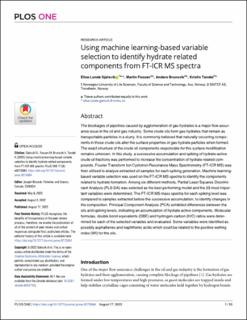| dc.contributor.author | Gjelsvik, Elise Lunde | |
| dc.contributor.author | Fossen, Martin | |
| dc.contributor.author | Brunsvik, Anders | |
| dc.contributor.author | Tøndel, Kristin | |
| dc.date.accessioned | 2022-12-08T13:51:47Z | |
| dc.date.available | 2022-12-08T13:51:47Z | |
| dc.date.created | 2022-08-18T15:06:58Z | |
| dc.date.issued | 2022 | |
| dc.identifier.citation | PLOS ONE. 2022, 17(8): e0273084. | en_US |
| dc.identifier.issn | 1932-6203 | |
| dc.identifier.uri | https://hdl.handle.net/11250/3036831 | |
| dc.description.abstract | The blockages of pipelines caused by agglomeration of gas hydrates is a major flow assurance issue in the oil and gas industry. Some crude oils form gas hydrates that remain as transportable particles in a slurry. It is commonly believed that naturally occurring components in those crude oils alter the surface properties of gas hydrate particles when formed. The exact structure of the crude oil components responsible for this surface modification remains unknown. In this study, a successive accumulation and spiking of hydrate-active crude oil fractions was performed to increase the concentration of hydrate related compounds. Fourier Transform Ion Cyclotron Resonance Mass Spectrometry (FT-ICR MS) was then utilised to analyse extracted oil samples for each spiking generation. Machine learning-based variable selection was used on the FT-ICR MS spectra to identify the components related to hydrate formation. Among six different methods, Partial Least Squares Discriminant Analysis (PLS-DA) was selected as the best performing model and the 23 most important variables were determined. The FT-ICR MS mass spectra for each spiking level was compared to samples extracted before the successive accumulation, to identify changes in the composition. Principal Component Analysis (PCA) exhibited differences between the oils and spiking levels, indicating an accumulation of hydrate active components. Molecular formulas, double bond equivalents (DBE) and hydrogen-carbon (H/C) ratios were determined for each of the selected variables and evaluated. Some variables were identified as possibly asphaltenes and naphthenic acids which could be related to the positive wetting index (WI) for the oils. | |
| dc.description.abstract | Using machine learning-based variable selection to identify hydrate related components from FT-ICR MS spectra | |
| dc.language.iso | eng | en_US |
| dc.title | Using machine learning-based variable selection to identify hydrate related components from FT-ICR MS spectra | en_US |
| dc.title.alternative | Using machine learning-based variable selection to identify hydrate related components from FT-ICR MS spectra | en_US |
| dc.type | Journal article | en_US |
| dc.type | Peer reviewed | en_US |
| dc.description.version | publishedVersion | |
| dc.source.volume | 17 | en_US |
| dc.source.journal | PLOS ONE | en_US |
| dc.source.issue | 8 | en_US |
| dc.identifier.doi | 10.1371/journal.pone.0273084 | |
| dc.identifier.cristin | 2044275 | |
| dc.relation.project | Norges forskningsråd: 294636 | |
| cristin.ispublished | true | |
| cristin.fulltext | original | |
| cristin.qualitycode | 1 | |
